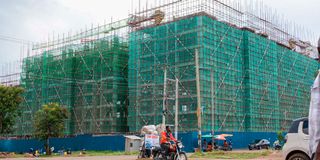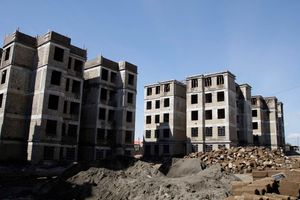
An upcoming affordable housing project by Gulf Cap Real Estate in Starehe, Nairobi.
Since the Kenya Kwanza Alliance took power in September 2022, the phrase “affordable housing” has become popular, making its way in almost all public discourses on real estate and other investments.
As the country’s population continues to grow and create a housing demand that far outstrips supply, successive governments have attempted to implement affordable housing programmes aimed at bridging the gap.
Though the initiative has to some extent helped address Kenya’s housing deficit, concerns have been emerging about the quality of life in some of the units constructed under the affordable housing scheme.
Despite paying a monthly service fee of Sh3,000, residents of an affordable housing project in Park Road, Ngara, expressed frustration over their deplorable living conditions.
Issues raised by the residents included poor sanitation, estate neglect, insecurity and persistent water shortages, with some having to pay up to Sh150 for a 20-litre container of water.
“The term ‘affordable’ is obviously relative, but whatever the case, it should not translate to poor quality. The two can be synonymous,” says Chris Ochieng', the Chief Executive Officer of Gulf Cap Real Estate, an affordable housing developer.

A model of Starehe Point affordable housing project by Gulf Cap Real Estate.
As in more developed economies, there are many strategies developers can employ locally to lower the cost of housing while upholding the workmanship quality, he says.
“Like millions of other Kenyans, I used to believe that residences with quality amenities were the preserve of those earning a lot of money. That was until I went to work as an engineer on real estate projects abroad,” he says.
Modern construction technologies, including tunnel and aluminium formwork, are extensively used abroad to lower the cost of construction. However, their use in Africa is still limited.
Though the upfront cost of these technologies is high, which is why they are not popular in Africa, their usage helps reduce wastage on sites and shorten construction time.
“An apartment floor that could take several weeks or months to complete could, for instance, be completed in just a week,” Ochieng says.
Since the time taken for a project with these technologies is greatly reduced, developers incur lower costs during construction. This cost-benefit can be transferred to the consumer.
“A project that would take up to five years to complete, like the one we are working on in Starehe, Nairobi County – dubbed 289 InCity Suites – could be completed in just two years,” Ochieng adds.
As they are fairly new in Africa, few artisans – or fundis as they are popularly known – can use these technologies effectively, but contracting professionals from abroad could cost more.
Ochieng says investing in professional development and upskilling staff by, for instance, sending some talents overseas to learn and return to share the knowledge could increase local usage of these technologies.
“You can only implement what you know. If you do not travel out there to understand these technologies, you can never apply the same here,” the engineer says.

Upcoming Anderson Estate in Kisumu City. There is need to streamline development approvals in order to guard against project delays.
In the last five years, factors like the Covid-19 pandemic and the persistent bloody conflicts in the Middle East and Europe, have led to blockages in supply chains, thus increasing the prices of goods and services.
“There have been instances where we have set a price and agreed with the client when the project starts. Halfway through, steel prices go up, yet you cannot go back and tell the client to consider that,” Ochieng says.
Disruptions in international supply chains have further resulted into project delays, which in addition to inflation, frequent tax increases and currency fluctuation, have resulted in a rise in construction costs.
Focusing on efficiencies in procurement, reducing on spending and planning in advance are, therefore, essential survival tactics for housing developers hoping to avoid financial difficulties, debts and insolvency.
“When projects drag, you waste money paying employees who are not working, offering conciliatory discounts to buyers and maintaining unused equipment. Timely completion of projects minimises spending,” he adds.
The engineer says developers may opt to focus on efficiencies in design, adopting strategies like water recycling and the use of natural lighting, to lower the cost of electricity and water.
“Instead of building perimeter walls for security in our projects, for instance, we build retail around, to attract human traffic that can serve as a natural security and generate revenue to cushion against cost overruns,” Ochieng states.
Being smart about the size of a unit can help with savings, as one item that hugely drives up the cost of a project is the square footage.
“You want to design a good unit, but how much space do you really need? Developers should move away from large units to more practical sizes,” Ochieng says.
Devaluation
Waste at the establishments can be separated at source to reduce the cost of collection and by extension, the service charge residents would pay for access to amenities in the estates as well.
“Often, people do not use amenities in estates because there is no supervision. Equipping amenities with trainers in sports, arts, education and religion could help to guard against this,” says Ochieng.
Developers can also procure materials that would safeguard their properties against devaluation over time as has been the case in many estates across the capital city, in order to encourage uptake from investors.
“Donholm for instance, where I was raised, was once considered as upper middle class, but that is no longer the case. Upholding the leasehold value of a property ensures even those who inherit it get good rental harvests,” Ochieng adds.

Mr Chris Ochieng', CEO of Gulf Cap Real Estate, at the company's housing project in Starehe, Nairobi.
Low-income households in cities majorly rely on public transit to access jobs, yet housing near transit tends to be more expensive, forcing these families to pay high rents or live far from accessible transit.
“Increasing the supply of affordable housing near transit can reduce the transport costs of low-income households – often the second-largest annual expense for families after housing – and thus encourage uptake,” the engineer says.
These strategies can go a long way in addressing Kenya’s housing crisis. However, Ochieng says they can only make sense if the issue of access to affordable credit – which remains one of the biggest barriers to home ownership in Kenya and on the continent in general – is addressed.
For one to access a house through a mortgage in Kenya, he or she may for instance, be required to pay a deposit of up to Sh200,000, which may not be feasible in a country whose average income is Sh50,000.
Similarly, albeit with good reason, most financial institutions will ask borrowers to produce items like formal payslips or bank statements, which many Kenyans – 80 per cent of whom are in the informal economy – do not have.
“That person at Gikomba open-air market, who saves Sh1,000 a day after selling clothes, uses part of the savings later to pay rent somewhere but because he does not have a formal payslip, he cannot access a mortgage,” Ochieng says.
Collaborative engagements between important stakeholders such as the government, developers and lenders could facilitate the creation of financial products that will increase the rate of home ownership.
“Homeownership should not be difficult, considering the money people spend on rent. If crucial stakeholders can absorb some of the lending risks, Kenyans will be able to own homes through tenant purchase schemes,” Ochieng adds.
From a policy perspective, Doreen Onwong’a – a partner at KN Law LLP – says there is need to ensure the Affordable Housing Fund, raised mainly through the Housing Levy, is used effectively.
Due to lower purchasing power occasioned by a tough economy, the rate at which consumers have been buying units has over the years been falling, making it difficult for developers to meet their loan obligations.
The affordable housing fund was established by the government in order to, among other reasons, encourage the participation of the private sector in the programme by reducing the chances of low buyer-uptake.
“The fund was a good idea. By providing some sort of ‘offtake guarantee’, it could encourage banks and other financial institutions to release the capital, but its impact is yet to be felt, with much of it invested in government securities,” Onwong’a says.
Without the support of the Fund, she says many developers are finding it difficult to get funding from the banks, which are not willing to release the capital without a guarantee of timely repayment.
Home ownership
She suggests that the Affordable Housing Fund be focused more on mitigating risk for developers as opposed to the end-buyers, who can be covered by the Kenya Mortgage Refinance Company.
“Proper risk transfer and management remains important to increasing the rate of home ownership. Once every party in the ecosystem plays its role effectively, everyone will benefit,” Onwong’a says.
In addition, the legal practitioner says it is important to establish robust reporting, monitoring and evaluation frameworks to ensure that government interventions achieve their desired outcomes.
“This will help ensure that the money raised for affordable housing is used appropriately, projects are completed as planned and the units constructed are allocated equitably,” Onwong’a adds.
For Alex Njage, Head of Commercial Property at Bowmans Kenya, there is need to streamline the process of obtaining tax incentives provided under the affordable housing programme, to boost project efficiency.
These incentives, which include tax deductibility for housing loans, incentives under stamp duty and lower taxes on housing bonds were proposed to encourage private sector investment in affordable housing.
However, Njage adds that at the moment, before developers can receive the incentives, their projects have to undergo lengthy verification at the State Department of Housing and the National Treasury.
While this verification is important, the bureaucracy in it creates many delays which affect cash flows, thus discouraging as opposed to encouraging, developers to participate in the affordable housing programme.
“Cash flow is king in construction. If the government could create and implement a functional one-stop-shop for evaluation and issuing of tax incentives for affordable housing, that would go a long way in ensuring profitable and high-quality projects,” Njage says.
Gilbert Kilonzo, an architect, says there is need to streamline development approvals in order to guard against project delays that often inflate construction, and by extension, housing costs.
“When a project is delayed, it puts a strain on the budget, and this causes contractors to cut corners, focus less on quality or pass on the added costs to consumers in order to remain profitable,” Kilonzo says.
According to the architect, public-private partnerships can help developers secure affordable land, navigate through land ownership and transfer hurdles and access incentives, enabling them to pass the cost-benefit to consumers.






